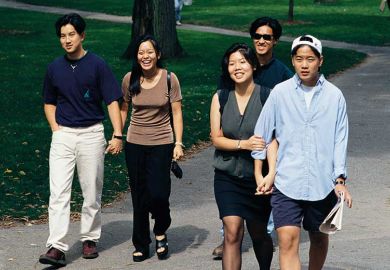University leaders have vowed to tackle racial inequality in US society as an analysis pointed out a major way that they may be contributing to the problem.
The study from Georgetown University acknowledges that black and Latino students are enrolling at US public institutions at record rates. Yet their college completion rates are slipping, the study found, as white students continue to be over-represented in public institutions with the best reputations, which deliver much higher graduation rates and lifetime earnings.
“States have created a tiered system”, the authors say, “that disproportionately provides whites with a first-class education in well-funded top-tier selective colleges.”
The nation’s racial divide was a central concern at the Association of Public and Land-grant Universities’ annual conference in New Orleans. Various forums on the topic, however, dwelled primarily on ways of helping students to engage with others and to succeed once they arrived at whichever campus accepted them. Even with the Harvard University case grabbing national attention, the question of affirmative action, and the choices that colleges make in assembling their student bodies, was largely overlooked at the APLU’s three-day gathering.
University leaders discussed campus programmes to encourage cross-racial interactions, tolerance and respect; community service efforts; the divisive national political tone; voter suppression campaigns; free-speech controversies; Confederate memorial disputes; micro-aggressions; and mentoring.
Ruth Simmons, president of Prairie View A&M University, a former president of Brown University and the first black person to lead an Ivy League institution, made an especially impassioned plea for students troubled by offensive speech to speak up rather than plead for campus “safe spaces” where particular types of discussion are banned. Growing up on a sharecropper plantation in Texas with black and white farmers, Professor Simmons said, taught her to live with people who aggressively disagreed with her existence.
“The fact that we knew people hated us, and had utter disrespect for us, didn’t prevent us from also working with them,” Professor Simmons said. “It’s the most amazing thing – and I don’t recommend going back to those times – but that proximity delivered a very positive outcome for most of us who grew up in that. And that is, we learned how to deal with people.”
The chief APLU initiative outlined at the conference, dubbed Powered by Publics, involves gathering 130 of its member institutions in groups of six to 12 colleges each to identify and develop best methods for helping their students, especially minorities, complete their degrees.
The Georgetown report, meanwhile, suggests that US public colleges could be most helpful in promoting degree completion among minorities if they began by revisiting their admissions policies.
The analysis, produced by Georgetown’s Centre on Education and the Workforce, notes that selective public colleges, compared with open-access public institutions, spend nearly three times as much money on their students, who in turn have an 85 per cent chance of graduating. Students at unselective institutions have only a 51 per cent chance, it says.
US public colleges have more than enough qualified black and Latino applicants, but such students often are excluded by an overreliance on standardised tests that are poor predictors of college success, the Georgetown authors say. Among those who do find their way into selective public colleges, black and Latino students have an 81 per cent graduation rate, close to the 86 per cent rate among white students, the report says.
The admissions gap becomes a lifetime handicap, given the earnings value of a college degree, the study says. The income difference between college graduates and high school graduates accounts for 60 per cent to 70 per cent of the nation’s growth in pay inequality since the 1980s, it says.
“The selective public higher education system”, the Georgetown authors write, “has become another brick in the wall that holds back blacks and Latinos.”
Register to continue
Why register?
- Registration is free and only takes a moment
- Once registered, you can read 3 articles a month
- Sign up for our newsletter
Subscribe
Or subscribe for unlimited access to:
- Unlimited access to news, views, insights & reviews
- Digital editions
- Digital access to THE’s university and college rankings analysis
Already registered or a current subscriber?








